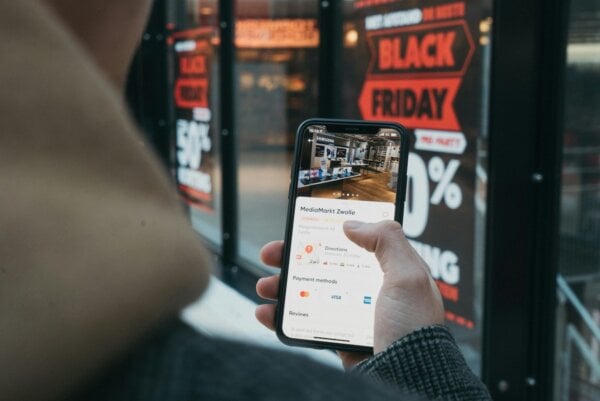
Why “We Can’t Compete Without MAP” Is the Wrong Problem to Solve
How smart ecommerce brands reframe price disadvantages into a competitive optimization strategy.
Let’s address the elephant in the room. Companies without minimum advertised price (MAP) policies are putting their ecommerce teams in a tough situation.
According to McKinsey research, nearly 40% of consumers switch retailers to get better deals.
The challenge is no different from the classic showrooming problem that has plagued retailers for over a decade. Your customers discover your products, compare, and then disappear to buy from wholesalers, retailers, or resellers offering lower prices.
Because they can’t compete on price and leadership won’t budge on enforcing a MAP policy, many teams will simply throw their hands up and concede that 40% of price-sensitive shoppers will buy elsewhere.
Before you do that, I want to share an alternative POV. After working with hundreds of ecommerce brands to increase conversions, there are some tried and true strategies that will deliver in spite of MAP restrictions.
It starts with reframing the situation. Customer acquisition isn’t the problem. Customer preference is.
Instead of trying to win the price war, it’s time to focus on better customer experiences and compete in areas that can’t be replicated by the competition.
Solution 1: Make the experience worth the premium
The insight: 72% of consumers expect personalized experiences. Resellers can’t always deliver them.
While you can buy Glossier products at retailers like Ulta and Target, Glossier’s direct channels offer something those retailers can’t: a personalized skincare quiz that analyzes your skin type and concerns to curate 3-5 products specifically for your needs.
Their website shows personalized product recommendations based on your quiz results and browsing behavior, creating a tailored experience that feels custom-made.
This is the idea of selling the experience of being your customer and making it a seamless, one-of-a-kind experience to shop with you.
What this looks like in practice:
- Real-time AI personalization throughout the shopping experience
- Immersive product discovery via recommendations
- Clear articulation of your brand values and differentiators relevant to each unique user
- Brand storytelling that makes the purchase decision emotional instead of transactional
Solution 2: Create exclusivity that other sellers can’t touch
The insight: Exclusive SKUs and premium products can command 20-30% higher profit margins. While your resellers can sell your products, they can’t sell your brand or your relationship with customers.
Nike didn’t always beat resellers by matching prices. They created SNKRS app exclusives and limited colorways that resellers literally cannot obtain, contributing significantly to digital revenue and spiking DTC sales during the pandemic.
The strategy works because exclusivity creates urgency, and urgency often trumps price sensitivity.
What exclusive access looks like:
- Brand-only colorways and limited editions
- Early access windows 24-48 hours before reseller inventory
- Extended size runs available only through your channels
- Bundle combinations that resellers can’t replicate
Solution 3: Build loyalty programs that compete with discounting
The insight: Experience-based loyalty programs can make the shopping experience delightful without lowering prices.
84% of customers say they’re more likely to engage with a brand that offers a loyalty program, which is a game-changer for ecommerce companies without MAP policies.
For example, members of Sephora’s Beauty Insider program generate 80% of its total sales. While the program doesn’t guarantee products at the lowest price, it does offer exclusive access, personalized services, and community benefits that competitors cannot provide.
Loyalty programs that work:
- Tier-based structures with exclusive access benefits
- Community elements that create network effects
- Experiential rewards that resellers can’t match
- Personalized services that add genuine value
Enjoying this article?
Subscribe to our newsletter, Good Question, to get insights like this sent straight to your inbox every week.
Solution 4: Optimize every conversion touchpoint
The insight: When you can’t compete on price, every visitor becomes precious. Optimizing the digital experience can offset price disadvantages.
Munchkin faced this exact challenge competing with retailers like Target and Walmart, where their products were sold. Working with The Good, they discovered that 70% of their traffic was mobile, but frustrated users were bouncing due to annoying pop-ups and poor navigation.
As David Embree from Munchkin put it, “If you’re paying to invite someone to your store, you don’t want them to walk in and immediately turn around to go somewhere else.”
By removing invasive popups, optimizing mobile navigation, and improving product findability, Munchkin decreased its bounce rate significantly and saw a lift in site-wide KPIs within six months.
What a powerful optimization strategy looks like:
- Comprehensive audit of user behavior and analytics data to identify conversion barriers
- Prioritized solutions that turn barriers into opportunities
- A/B testing and other experimentation methods to validate site improvements
- Device-specific optimization to customize the experience
- Navigation improvements to help users find specific products instead of browsing aimlessly
- Streamlined purchase paths that eliminate every source of friction
- Sophisticated abandoned cart recovery that addresses objections and provides additional value
Solution 5: Leverage tech to offer innovative shopping experiences
The insight: While resellers focus on price optimization, you can invest in technological advances that create immediate competitive advantages.
Warby Parker’s AR try-on experience through their site and mobile app allows customers to virtually test frames from home. The company’s annual report mentions that try-on features contribute to customer satisfaction, which is known to increase conversion rates.
Advanced technology requires significant investment that discount-focused resellers can’t justify for all the product types in their store. But it creates customer experiences that justify premium pricing and drive conversion improvements.
What technology differentiation looks like:
- AR try-on experiences
- Real-time personalization that updates offers based on customer activity
- Predictive analytics that anticipate customer needs/interests
- Social commerce
Solution 6: Lean on your brand story and values to connect with customers
The insight: Your resellers are selling your product, but they can’t sell your story.
Olipop transformed the crowded soda market by crafting a compelling narrative around gut health and nostalgia.
While Amazon can stock their prebiotic sodas, they can’t replicate the brand’s authentic story about making childhood favorites functional for adult wellness.
This storytelling creates emotional connections that justify premium pricing. Customers pay $2.50 for an Olipop versus $1 for a Coke because they’re buying into a healthier lifestyle narrative. They also have a subscription program that makes it easy for customers to restock every month.
Weaving the brand story into everything, from blog articles to stats on quality, helps customers build a direct relationship with your brand.
Content strategies that differentiate:
- Educational content that positions you as the industry expert
- User-generated content that creates social proof and community engagement
- Brand storytelling using elements like quality tiles to connect with customer values
Solution 7: Try product bundling to create value
The insight: Retailers may have lower prices on individual products, but you can create bundles to provide unreplicable value.
Harry’s grooming bundles products to make it easier for customers to find what they need for a smooth shave. Terms like “complete suite” and “essentials” create the perception of necessity while offering genuine convenience.
Smart product bundling makes price comparison impossible because customers can’t find identical packages elsewhere. The strategy works because bundles provide genuine convenience and a perception of value.
What strategic bundling looks like:
- Product combinations with complementary items, services, or accessories
- Value-added services like installation, setup assistance, or training included
- Exclusive package deals available only through your channel
Solution 8: Create unbeatable service experiences
The insight: Exceptional customer service can become a primary differentiator when price competition is off the table.
REI’s legendary approach exemplifies this strategy through its unmatched 100% satisfaction guarantee and return policy. Members can return any REI product at any time for any reason, with no questions asked, even if they’ve used it for years.
The policy extends beyond just returns to include their expert gear consultation services, where knowledgeable staff help customers choose the right equipment for their specific outdoor adventures, and their extensive educational programs, including classes on everything from rock climbing to bike maintenance.
Superior service creates defensible advantages because it requires investment in people and processes that discount-focused resellers can’t justify. The key is making the service itself a reason to choose you.
What service excellence looks like:
- Pre-sale consultation and personalized product selection guidance
- Extended warranties and satisfaction guarantees that competitors can’t match
- Omnichannel service consistency across online, phone, chat, and in-store
- Post-purchase support that turns customers into advocates
Understanding customer psychology and your unique users
Research shows that price is rarely the only factor in purchase decisions, even for price-sensitive customers. So, understanding the foundations of customer psychology and what matters is crucial when competing beyond price.
Some of the foundational elements of customer psychology are true no matter what you offer:
- Trust and Credibility: Customers often pay premium prices for retailers they trust. Build credibility through professional website design, clear policies, security certifications, and transparent business practices.
- Convenience and Time Savings: Many customers value convenience more than small price differences. Streamlined shopping experiences, fast shipping, and easy returns can justify MAP pricing.
- Risk Reduction: Customers often choose established retailers to reduce purchase risk. Comprehensive return policies, warranties, and a reputation for reliability can overcome price objections.
But there are other user behaviors that will be unique to your customers. Doing the research to understand what they want and need is the best way to deliver experiences that can compete when your company doesn’t have minimum advertised price policies in place.
Compete on value, not on price
MAP policy restrictions don’t have to be conversion killers. They can be conversion redirectors that allow you to compete differently.
While the wholesalers, retailers, and resellers race to the bottom on price, you can build sustainable differentiation through superior customer experience, expert service, and strategic value creation.
The ecommerce teams that thrive under MAP constraints understand a fundamental truth: customers don’t always buy from the cheapest option. They buy from the option that provides the most value. Your job is to ensure that option is always yours.
Ready to transform your MAP constraints into competitive advantages? The strategies outlined here require systematic implementation and continuous optimization. At The Good, we specialize in helping ecommerce brands optimize their conversion strategies when traditional price competition isn’t an option.
Let’s talk and see if there could be a good fit.
Now It’s Your Turn
We harness user insights and unlock digital improvements beyond your conversion rate.
Let’s talk about putting digital experience optimization to work for you.

About the Author
Jon MacDonald
Jon MacDonald is founder and President of The Good, a digital experience optimization firm that has achieved results for some of the largest companies including Adobe, Nike, Xerox, Verizon, Intel and more. Jon regularly contributes to publications like Entrepreneur and Inc.